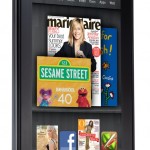Elon Musk’s AI chatbot Grok has once again found itself at the centre of controversy after the most recent update to Grok 3 triggered…
Not a Review: Gobii digital photo frame

Most of us need a digital photo frame like we need a hole in the head. In the era of flat panel TVs to which we can effortlessly beam images, or into which we can stuff USB cards filled with an endless supply of inane holiday snaps, crossing-the-harrassment-line staff party pics, minute details of bloody baby showers and simpering soft-focus wedding pictures, digital photo frames — even cheap photo frames such as this one from Gobii — matter no more than a Kardashian nuptials. What possible reason to stuff this turkey down your Christmas stocking?
If digital photo frames are to be remotely useful, they need to be less expensive and more like a tablet. Why bother with an ugly carousal of holiday images jerking spasmodically from one image to the next, when you can prop up your iPad and enjoy smooth picture transitions paired with the sweet sounds of Wham’s “Last Christmas” for the full Christmassy effect (substitute the Lowenstiens or Dana Halabi as neccessary)? Tablets, man, tablets changed the game so outrageously that mere photoframes look like crap in comparison. Not that they were anything other before.
Let’s look at the Gobii eight-inch digital picture frame for what it is. It’s a cheap and unbelievably flimsy digital photo frame that screams “Made in China” from the moment you wrench it from the box, and for every moment after. It’s industrial design is execrable, just a lump of shaved down moulded plastic containing the world’s worst LCD screen. The controls, located on the back of the frame, will be fiddled with once or twice, then never touched again. The trauma of bringing my precious and delicate skin into contact with its poorly moulded wretchedness is too much to bear. When I tried to turn the Gobii on for the first time, nothing happened. No light came on to tell me that it was powering up, no sounds serenely chimed to the world signifying some kind of electronic life. Nothing.
So I left the Gobii and continued to glare at it fiercely from a distance. The manual was no help (only the weak need manuals) so I made my own plan. I jammed a USB stick loaded with images into the side of the device and poked my finger into the “On” button with pitiless determination. Bend to my will, or I shall rend thee asunder with great rending. The feeble clicking noise produced no joy. Now filled with a just and righteous anger, I assaulted the USB stick with aggressive intent, and lo, images suddenly started displaying on the screen. It seems that the Gobii picture frame has to be broken in like a fine mustang stallion. Or a simpering henchman. Either way, its sudden cooperation was thankfully just in time , as I was about to tear it a new one.
Disregard the barely aesthetic aesthetics, ignore the USB stick poking awkwardly out the side of the Gobii (unless you use the SD card option), and look even past the medical-looking chromed leg you have to screw in to make the Gobii stand upright. And behold…nothing more. The Gobii is a relic of the past, a single-use device which had little reason for being, and now has even less. Burn it with fire, my children of the gadget. Grab it from Kalahari.com if you must.



